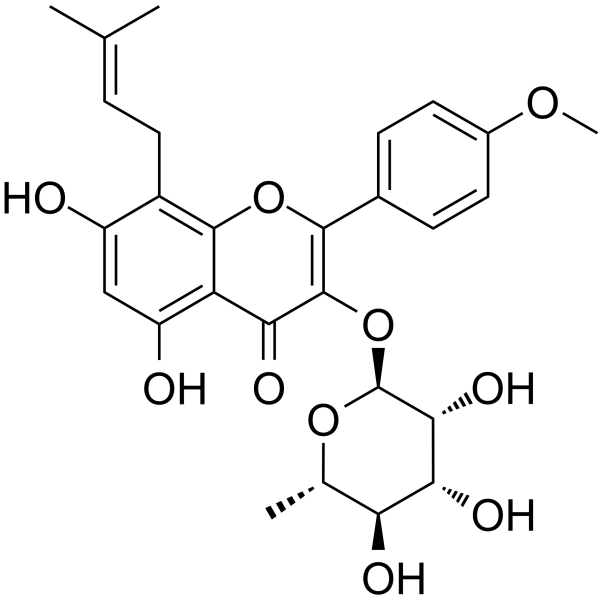天然产物 糖类和糖苷 Saccharides and Glycosides
Baohuoside I;(Synonyms: 宝藿苷 I; Icariin-II; Icariside-II) 纯度: 99.15%
Baohuoside I 是从朝鲜淫羊藿中得到的黄酮类化合物,作为 CXCR4 的抑制剂,能够抑制 CXCR4 的表达,诱导凋亡,具有抗肿瘤活性。

Baohuoside I Chemical Structure
CAS No. : 113558-15-9
| 规格 | 价格 | 是否有货 | 数量 |
|---|---|---|---|
| 10;mM;*;1 mL in DMSO | ¥1320 | In-stock | |
| 5 mg | ¥800 | In-stock | |
| 10 mg | ¥1200 | In-stock | |
| 50 mg | ¥4800 | In-stock | |
| 100 mg | ¥6500 | In-stock | |
| 200 mg | ; | 询价 | ; |
| 500 mg | ; | 询价 | ; |
* Please select Quantity before adding items.
Baohuoside I 相关产品
bull;相关化合物库:
- Natural Product Library Plus
- Bioactive Compound Library Plus
- Apoptosis Compound Library
- GPCR/G Protein Compound Library
- Immunology/Inflammation Compound Library
- Natural Product Library
- Anti-Cancer Compound Library
- Small Molecule Immuno-Oncology Compound Library
- Glycoside Compound Library
- Endocrinology Compound Library
- Phenols Library
- Traditional Chinese Medicine Monomer Library
- Flavonoids Library
- Anti-Breast Cancer Compound Library
| 生物活性 |
Baohuoside I, a flavonoid isolated from Epimedium koreanum Nakai, acts as an inhibitor of CXCR4, downregulates CXCR4 expression, induces apoptosis and shows anti-tumor activity. |
||||||||||||||||
|---|---|---|---|---|---|---|---|---|---|---|---|---|---|---|---|---|---|
| IC50 Target |
|
||||||||||||||||
| 体外研究 (In Vitro) |
Baohuoside I is an inhibitor of CXCR4, and downregulates CXCR4 expression at 12-25 μM. Baohuoside I (0-25 μM) suppresses NF-κB activation in a dose-dependent manner, suppresses CXCL12 induced the invasion of cervical cancer cells. Baohuoside I also inhibits invasion of breast cancer cells[1]. Baohuoside I inhibits A549 cell viability, with IC50s of 25.1 μM at 24 h, 11.5 μM and 9.6 μM at 48 h and 72 h, respectively. Baohuoside I ((25 μM) suppresses the caspase cascade in A549 cells, elevates ROS levels and activates JNK and p38MAPK signaling cascade[2]. Baohuoside I (3.125, 6.25, 12.5, 25.0 and 50.0 µg/mL) significantly and dose-dependently blocks the growth of esophageal squamous cell carcinoma Eca109 cells, with an IC50 of 4.8 µg/mL at 48 h[3]. MCE has not independently confirmed the accuracy of these methods. They are for reference only. |
||||||||||||||||
| 体内研究 (In Vivo) |
Baohuoside I (25 mg/kg) decreases β-catenin protein levels, cyclin D1 and survivin expression in nude mice[3]. MCE has not independently confirmed the accuracy of these methods. They are for reference only. |
||||||||||||||||
| 分子量 |
514.52 |
||||||||||||||||
| Formula |
C27H30O10 |
||||||||||||||||
| CAS 号 |
113558-15-9 |
||||||||||||||||
| 中文名称 |
宝藿苷 I;淫羊藿次苷 Ⅱ;宝霍苷 I |
||||||||||||||||
| 运输条件 |
Room temperature in continental US; may vary elsewhere. |
||||||||||||||||
| 储存方式 |
|
||||||||||||||||
| 溶解性数据 |
In Vitro:;
DMSO : ≥ 32 mg/mL (62.19 mM) * “≥” means soluble, but saturation unknown. 配制储备液
*
请根据产品在不同溶剂中的溶解度选择合适的溶剂配制储备液;一旦配成溶液,请分装保存,避免反复冻融造成的产品失效。 In Vivo:
请根据您的实验动物和给药方式选择适当的溶解方案。以下溶解方案都请先按照 In Vitro 方式配制澄清的储备液,再依次添加助溶剂: ——为保证实验结果的可靠性,澄清的储备液可以根据储存条件,适当保存;体内实验的工作液,建议您现用现配,当天使用; 以下溶剂前显示的百
|
||||||||||||||||
| 参考文献 |
|
| Cell Assay [2] |
The cytotoxicity effect of Baohuoside I on A549 cells is determined by MTT assay. Cells (1×104 cells/well) are seeded in a 96-well plate, and treated with Baohuoside I (6.25, 12.5, and 25 μM) or 1 mM NAC for 24, 48 or 72 h. After MTT containing medium is removed, the crystals that have formed are dissolved by the addition of DMSO to each well. After mixing, the absorbance of the cells is measured at 540 nm by using Multiskan Spectrum Microplate Reader[2]. MCE has not independently confirmed the accuracy of these methods. They are for reference only. |
|---|---|
| Animal Administration [3] |
Mice[3] MCE has not independently confirmed the accuracy of these methods. They are for reference only. |
| 参考文献 |
|
